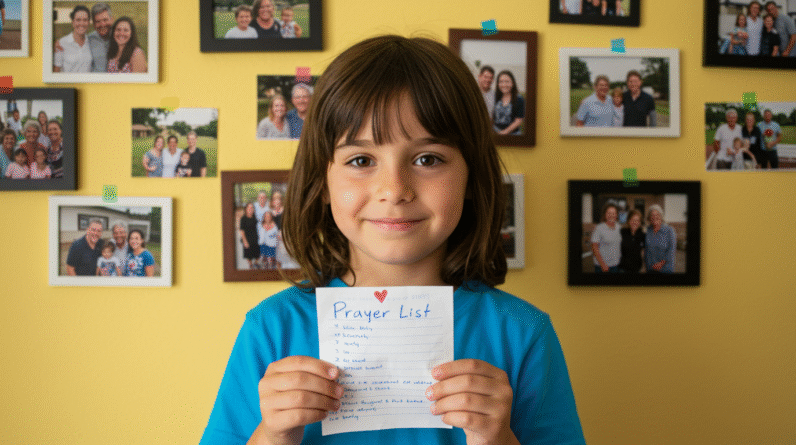Teaching Your Kids to Pray by Example: A Parent’s Role
Hey there, fellow parent! Let’s talk about something that’s deeply personal yet profoundly impactful—teaching kids to pray. If you’re imagining it as a Sunday morning lecture or a chore, let’s pivot that thought. Think of prayer as a thread weaving through your daily family life, a living dialogue that connects generations. When your kids learn to pray through your example, you’re not just teaching a routine; you’re instilling in them the seeds of a lifelong friendship with God.
The Significance of Teaching Kids to Pray
Why is teaching prayer to your children so important? Prayer is more than just words uttered before bedtime. It’s a conduit to a relationship with God, a foundation for spiritual growth, and a source of comfort and strength throughout life. As parents, your role in teaching kids to pray by example shapes their understanding of faith, compassion, and community from an early age.
Your Life Is the Blackboard
You don’t need to be a theologian to show your kids how to pray. Start by integrating prayer into the natural rhythm of your household. Your morning coffee could be accompanied by a silent prayer of gratitude or humming a tune of praise in the car on the way to school. Kids are sponges, absorbing subtleties and nuances in their environment. By witnessing your everyday rituals and incorporating prayer naturally, they’re more likely to adopt it as part of their own daily life.
The Power of Modeling
Actions speak louder than words, and your kids are more likely to follow what you do rather than what you say. If they see you kneeling by your bed in prayer, lost in conversation with God, they’ll understand that prayer is a dialogue—an exchange between creator and creation, one that matters. Your example is powerful, perhaps more than you know. 1 Thessalonians 5:16-18 reminds us to “Rejoice always, pray continually, give thanks in all circumstances; for this is God’s will for you in Christ Jesus.”
Creating Daily Prayer Touchpoints
Life is busy, chaotic even. Sometimes, it’s tempting to let prayer fall through the cracks. However, establishing small, consistent touchpoints for prayer can make a significant difference.
Breakfast Blessings
Kickstart your day by acknowledging God’s presence. A quick prayer of thanks for the meal, provision, and the day ahead is simple yet significant. Your children will see this as a normal extension of their mealtime routine. It’s a chance to pause, breathe, and align intentions as a family right from the get-go.
Bedtime Quiet Moments
As you tuck your little ones into bed, create a peaceful moment of reflection and prayer. Encourage them to speak with God about their joys and worries, achievements, and failures. This habit not only builds a lifetime of relationship with God but also fortifies the bond between you and your child. And let’s face it, after a long day, who couldn’t use a quiet moment to reflect? Philippians 4:6 advises, “Do not be anxious about anything, but in every situation, by prayer and petition, with thanksgiving, present your requests to God.”
Family Prayer Time
Set aside a weekly prayer time where everyone comes together. It could be around the dinner table, in the living room, or even during a family walk. Use this time to express gratitude, pray for others, and perhaps even study a Bible verse. This not only reinforces the importance of faith but also builds a family culture of open conversation and mutual support.
The Centerpiece of Gratitude
Creating a “gratitude centerpiece” where the family writes down things they’re thankful for on slips of paper can be a wonderful way to incorporate prayer. Once a week, read them aloud during your family prayer time, weaving moments of gratitude into a shared prayer. This visual practice can help children grasp the abstract concept of counting their blessings.

Overcoming Challenges in Teaching Kids to Pray
Let’s get real—teaching kids to pray isn’t always a walk in the park. It comes with its own set of challenges, which you can navigate with a bit of creativity and patience.
Keep It Relatable
Children, especially the younger ones, can find abstract concepts like prayer difficult to understand. Make it relatable. Use language they understand, simplify stories from Scripture that emphasize the importance of prayer, and use everyday situations to show them how prayer can be intertwined with life. Mark 10:14 encourages us, saying, “Let the little children come to me, and do not hinder them, for the kingdom of God belongs to such as these.”
Address Skepticism with Empathy
As children grow, questions and doubts about prayer and faith may arise. Encourage questions and listen empathetically. It’s a delicate balance between doctrine and personal journey. Share your own experiences, the ebb and flow of your faith, and how prayer has been a backbone through life’s trials.
Handling Distractions
Modern life is filled with distractions, from digital screens to overscheduled calendars. Setting aside intentional time for prayer without distractions shows your kids the value you place on it. Allow them to have a say in how and when these moments happen, so they feel ownership and look forward to them.
Prayer as a Personal Relationship with God
Teaching kids to pray is essentially inviting them into the understanding that prayer is building a personal relationship with God. It’s about speaking to God as a trusted friend, not a distant entity. Explain the idea that God knows us intimately and desires to be part of our daily lives. Such an understanding fosters a stronger connection and encourages sincerity in their prayers.
Adventures in Listening
Prayer is as much about listening as it is about speaking. Teach your kids the importance of silence and reflection, of being open to hearing God’s voice, whether it’s through Scripture, nature, or the gentle whispers of their heart.
Encouraging Ownership of Prayer
Encourage your kids to personalize their prayers. There’s no “right” way to pray. Encourage them to use language that feels comfortable. They can keep a prayer journal, write letters to God, or create drawings that express their thoughts and conversations with Him.
Prayer as Encouragement
Guide your children to use prayer as a form of encouragement, not just for themselves, but for others. They can pray for friends, teachers, or those in need. This builds a sense of empathy and community, reinforcing the idea that prayer is a force of love and support in the world.
Guidance from the Bible
The Bible offers a treasure trove of wisdom on prayer. Sharing stories and verses about prayer will instill a deeper understanding in your children. Matthew 6:9-13, also known as the Lord’s Prayer, is a wonderful starting point for explaining elements of prayer such as reverence, confession, and supplication.
Conclusion: The Legacy of Prayer
By teaching kids to pray through your example, you’re passing on a treasured legacy, one that transcends material wealth or worldly success. This legacy of faith, communication, and love has the power to guide them throughout their lives, long after they leave the nest.
Explore More
For further reading and encouragement, check out these posts:
👉 7 Bible Verses About Faith in Hard Times
👉 Job’s Faith: What We Can Learn From His Trials
👉 How To Trust God When Everything Falls Apart
👉 Why God Allows Suffering – A Biblical Perspective
👉 Faith Over Fear: How To Stand Strong In Uncertain Seasons
👉 How To Encourage Someone Struggling With Their Faith
👉 5 Prayers for Strength When You’re Feeling Weak

📘 Jesus and the Woman Caught in Adultery – Grace and Mercy Over Judgement
A powerful retelling of John 8:1-11. This book brings to life the depth of forgiveness, mercy, and God’s unwavering love.
👉 Check it now on Amazon
As a ClickBank Affiliate, I earn from qualifying purchases.
Acknowledgment: All Bible verses referenced in this article were accessed via Bible Gateway (or Bible Hub).
“Want to explore more? Check out our latest post on Why Jesus? and discover the life-changing truth of the Gospel!”








